University Essay: Workplace Technology and Worker Skill Erosion
VerifiedAdded on 2022/09/28
|9
|3268
|27
Essay
AI Summary
This essay examines the argument that as workplace technology becomes more sophisticated, workers are likely to lose important skills. It explores the impact of automation, robotics, and digital technologies on job roles and the potential for skill erosion. The essay analyzes various theories, including Maslow's hierarchy of needs, social learning theory, and Vroom's expectancy theory, to support its argument. It discusses how technology can lead to job displacement, changes in skill requirements, and the need for workforce adaptation through training and education. The essay also considers the economic and social consequences of technological advancements, including income inequality and the changing nature of work. Furthermore, it delves into specific examples, such as the Hadrian X construction robot, to illustrate the practical implications of technology on worker skills and job roles. The essay concludes by highlighting the importance of managing the transition to new technologies and preparing workers for the future of work.
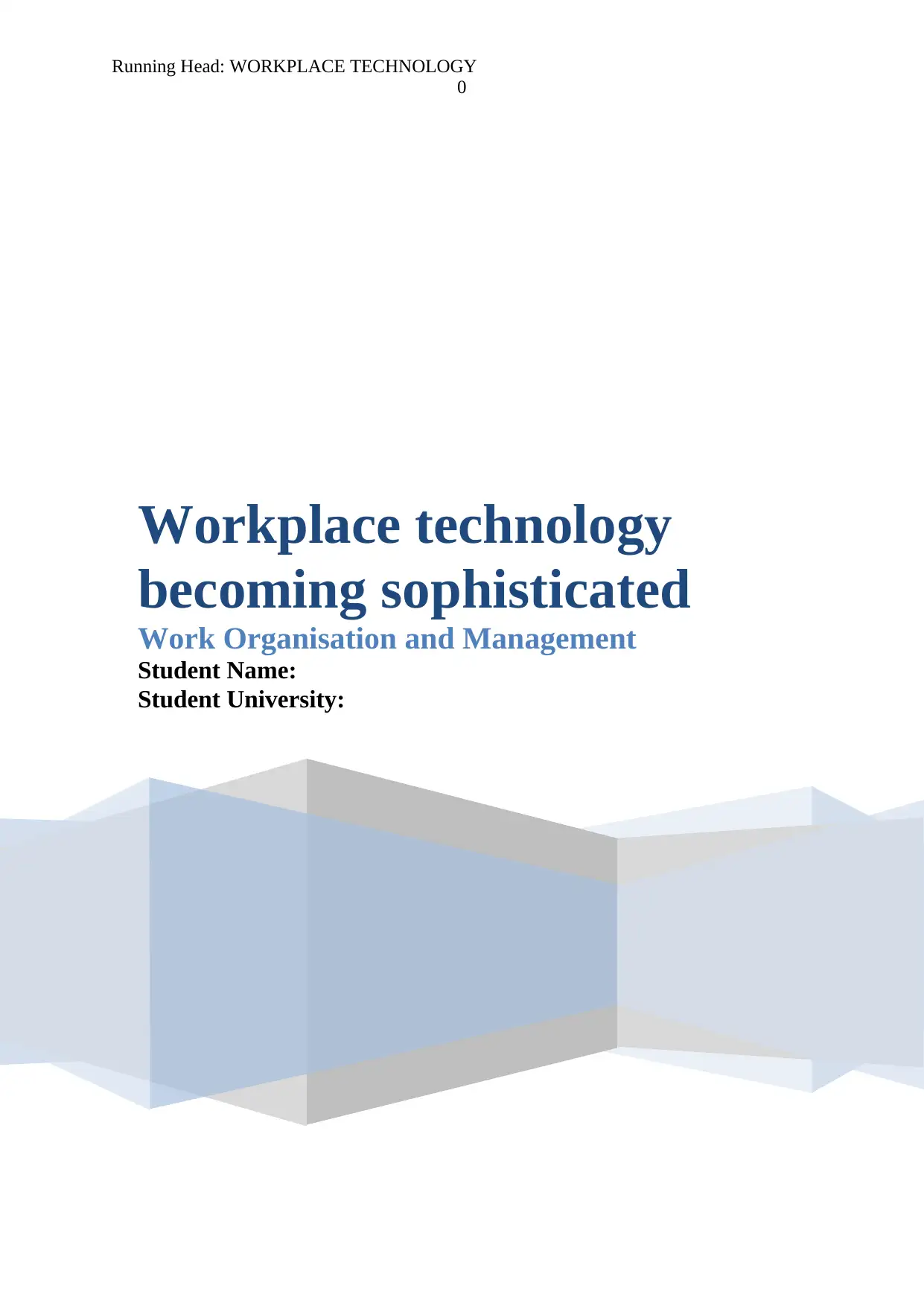
Running Head: WORKPLACE TECHNOLOGY
0
Workplace technology
becoming sophisticated
Work Organisation and Management
Student Name:
Student University:
0
Workplace technology
becoming sophisticated
Work Organisation and Management
Student Name:
Student University:
Paraphrase This Document
Need a fresh take? Get an instant paraphrase of this document with our AI Paraphraser
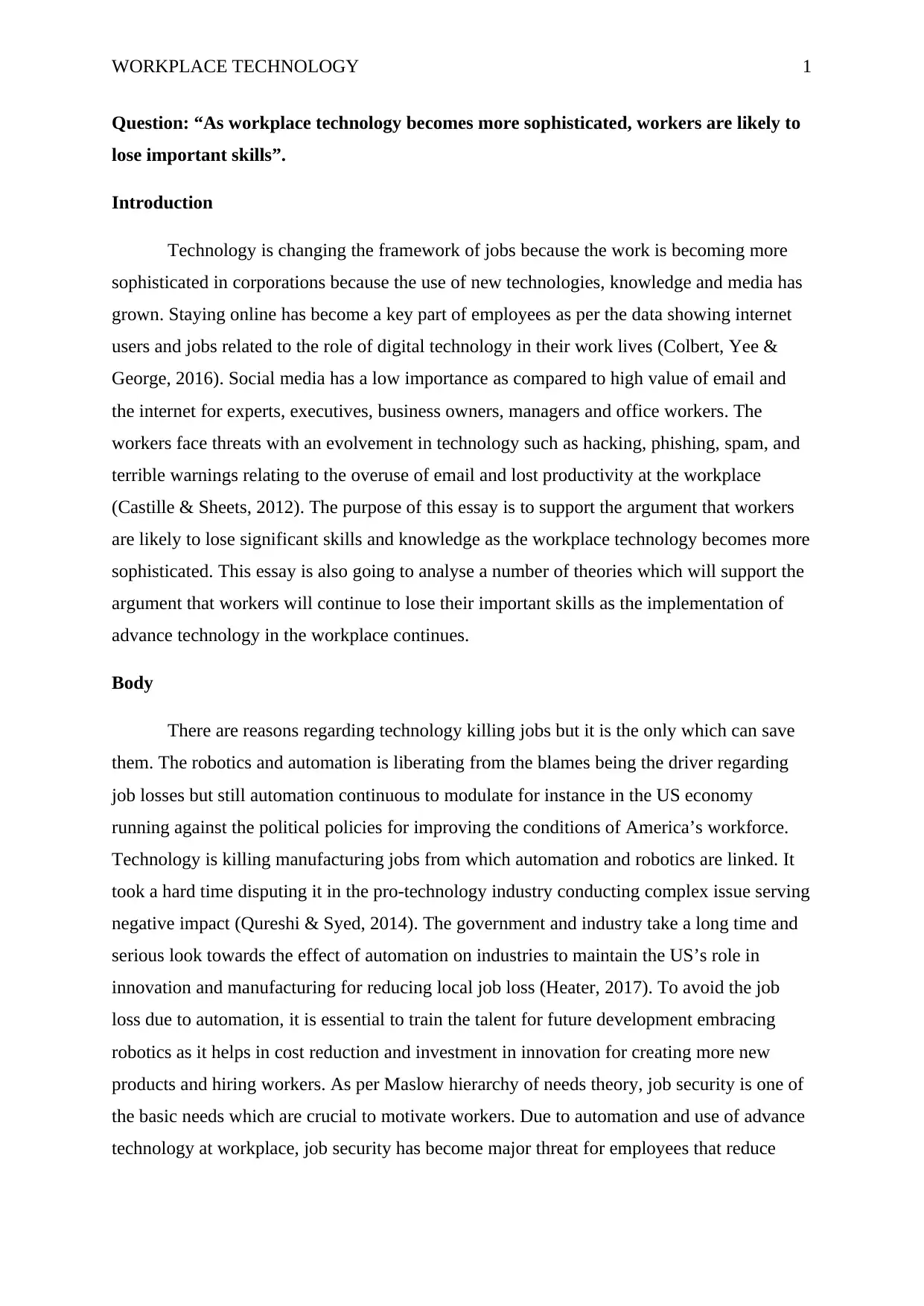
WORKPLACE TECHNOLOGY 1
Question: “As workplace technology becomes more sophisticated, workers are likely to
lose important skills”.
Introduction
Technology is changing the framework of jobs because the work is becoming more
sophisticated in corporations because the use of new technologies, knowledge and media has
grown. Staying online has become a key part of employees as per the data showing internet
users and jobs related to the role of digital technology in their work lives (Colbert, Yee &
George, 2016). Social media has a low importance as compared to high value of email and
the internet for experts, executives, business owners, managers and office workers. The
workers face threats with an evolvement in technology such as hacking, phishing, spam, and
terrible warnings relating to the overuse of email and lost productivity at the workplace
(Castille & Sheets, 2012). The purpose of this essay is to support the argument that workers
are likely to lose significant skills and knowledge as the workplace technology becomes more
sophisticated. This essay is also going to analyse a number of theories which will support the
argument that workers will continue to lose their important skills as the implementation of
advance technology in the workplace continues.
Body
There are reasons regarding technology killing jobs but it is the only which can save
them. The robotics and automation is liberating from the blames being the driver regarding
job losses but still automation continuous to modulate for instance in the US economy
running against the political policies for improving the conditions of America’s workforce.
Technology is killing manufacturing jobs from which automation and robotics are linked. It
took a hard time disputing it in the pro-technology industry conducting complex issue serving
negative impact (Qureshi & Syed, 2014). The government and industry take a long time and
serious look towards the effect of automation on industries to maintain the US’s role in
innovation and manufacturing for reducing local job loss (Heater, 2017). To avoid the job
loss due to automation, it is essential to train the talent for future development embracing
robotics as it helps in cost reduction and investment in innovation for creating more new
products and hiring workers. As per Maslow hierarchy of needs theory, job security is one of
the basic needs which are crucial to motivate workers. Due to automation and use of advance
technology at workplace, job security has become major threat for employees that reduce
Question: “As workplace technology becomes more sophisticated, workers are likely to
lose important skills”.
Introduction
Technology is changing the framework of jobs because the work is becoming more
sophisticated in corporations because the use of new technologies, knowledge and media has
grown. Staying online has become a key part of employees as per the data showing internet
users and jobs related to the role of digital technology in their work lives (Colbert, Yee &
George, 2016). Social media has a low importance as compared to high value of email and
the internet for experts, executives, business owners, managers and office workers. The
workers face threats with an evolvement in technology such as hacking, phishing, spam, and
terrible warnings relating to the overuse of email and lost productivity at the workplace
(Castille & Sheets, 2012). The purpose of this essay is to support the argument that workers
are likely to lose significant skills and knowledge as the workplace technology becomes more
sophisticated. This essay is also going to analyse a number of theories which will support the
argument that workers will continue to lose their important skills as the implementation of
advance technology in the workplace continues.
Body
There are reasons regarding technology killing jobs but it is the only which can save
them. The robotics and automation is liberating from the blames being the driver regarding
job losses but still automation continuous to modulate for instance in the US economy
running against the political policies for improving the conditions of America’s workforce.
Technology is killing manufacturing jobs from which automation and robotics are linked. It
took a hard time disputing it in the pro-technology industry conducting complex issue serving
negative impact (Qureshi & Syed, 2014). The government and industry take a long time and
serious look towards the effect of automation on industries to maintain the US’s role in
innovation and manufacturing for reducing local job loss (Heater, 2017). To avoid the job
loss due to automation, it is essential to train the talent for future development embracing
robotics as it helps in cost reduction and investment in innovation for creating more new
products and hiring workers. As per Maslow hierarchy of needs theory, job security is one of
the basic needs which are crucial to motivate workers. Due to automation and use of advance
technology at workplace, job security has become major threat for employees that reduce
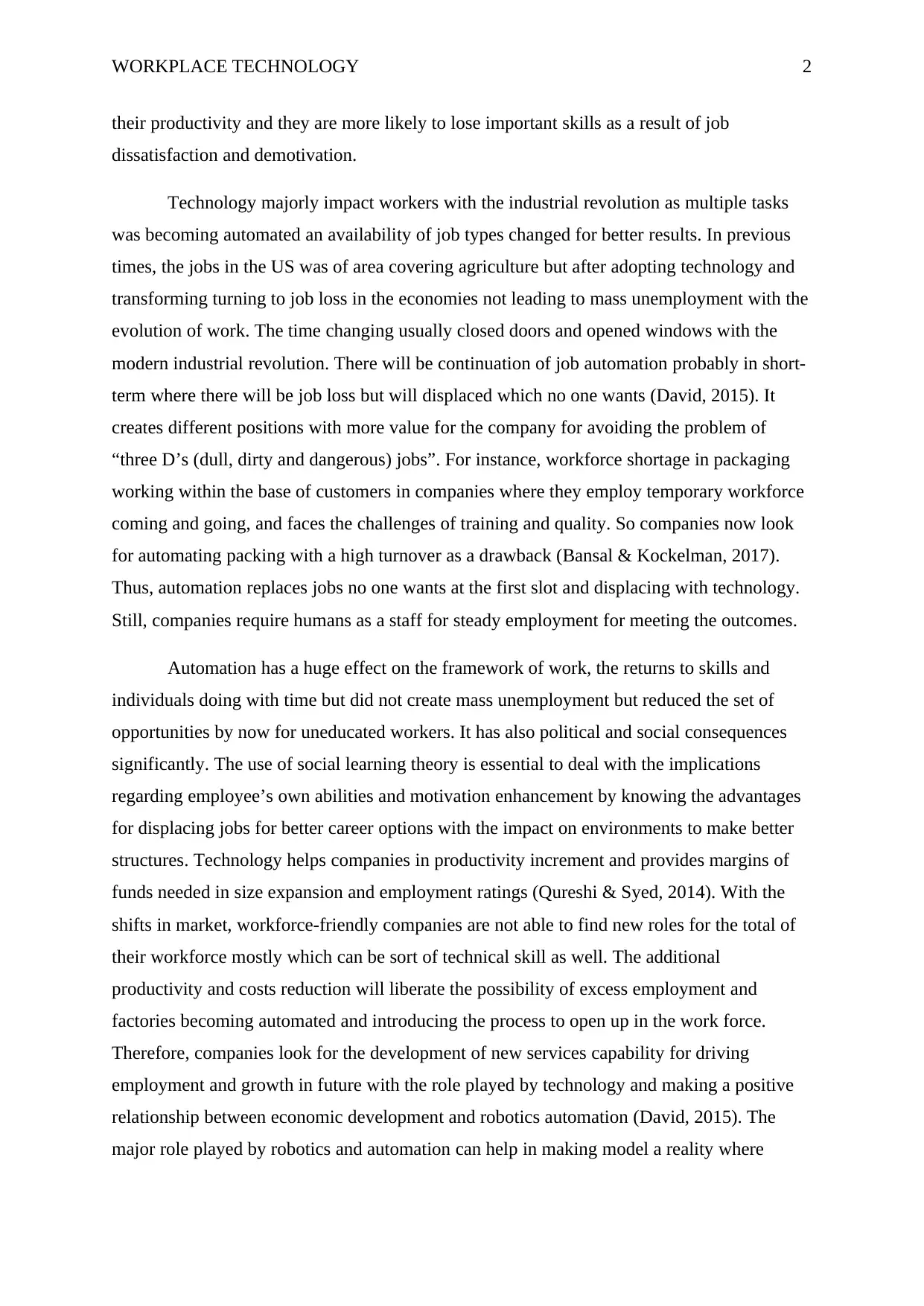
WORKPLACE TECHNOLOGY 2
their productivity and they are more likely to lose important skills as a result of job
dissatisfaction and demotivation.
Technology majorly impact workers with the industrial revolution as multiple tasks
was becoming automated an availability of job types changed for better results. In previous
times, the jobs in the US was of area covering agriculture but after adopting technology and
transforming turning to job loss in the economies not leading to mass unemployment with the
evolution of work. The time changing usually closed doors and opened windows with the
modern industrial revolution. There will be continuation of job automation probably in short-
term where there will be job loss but will displaced which no one wants (David, 2015). It
creates different positions with more value for the company for avoiding the problem of
“three D’s (dull, dirty and dangerous) jobs”. For instance, workforce shortage in packaging
working within the base of customers in companies where they employ temporary workforce
coming and going, and faces the challenges of training and quality. So companies now look
for automating packing with a high turnover as a drawback (Bansal & Kockelman, 2017).
Thus, automation replaces jobs no one wants at the first slot and displacing with technology.
Still, companies require humans as a staff for steady employment for meeting the outcomes.
Automation has a huge effect on the framework of work, the returns to skills and
individuals doing with time but did not create mass unemployment but reduced the set of
opportunities by now for uneducated workers. It has also political and social consequences
significantly. The use of social learning theory is essential to deal with the implications
regarding employee’s own abilities and motivation enhancement by knowing the advantages
for displacing jobs for better career options with the impact on environments to make better
structures. Technology helps companies in productivity increment and provides margins of
funds needed in size expansion and employment ratings (Qureshi & Syed, 2014). With the
shifts in market, workforce-friendly companies are not able to find new roles for the total of
their workforce mostly which can be sort of technical skill as well. The additional
productivity and costs reduction will liberate the possibility of excess employment and
factories becoming automated and introducing the process to open up in the work force.
Therefore, companies look for the development of new services capability for driving
employment and growth in future with the role played by technology and making a positive
relationship between economic development and robotics automation (David, 2015). The
major role played by robotics and automation can help in making model a reality where
their productivity and they are more likely to lose important skills as a result of job
dissatisfaction and demotivation.
Technology majorly impact workers with the industrial revolution as multiple tasks
was becoming automated an availability of job types changed for better results. In previous
times, the jobs in the US was of area covering agriculture but after adopting technology and
transforming turning to job loss in the economies not leading to mass unemployment with the
evolution of work. The time changing usually closed doors and opened windows with the
modern industrial revolution. There will be continuation of job automation probably in short-
term where there will be job loss but will displaced which no one wants (David, 2015). It
creates different positions with more value for the company for avoiding the problem of
“three D’s (dull, dirty and dangerous) jobs”. For instance, workforce shortage in packaging
working within the base of customers in companies where they employ temporary workforce
coming and going, and faces the challenges of training and quality. So companies now look
for automating packing with a high turnover as a drawback (Bansal & Kockelman, 2017).
Thus, automation replaces jobs no one wants at the first slot and displacing with technology.
Still, companies require humans as a staff for steady employment for meeting the outcomes.
Automation has a huge effect on the framework of work, the returns to skills and
individuals doing with time but did not create mass unemployment but reduced the set of
opportunities by now for uneducated workers. It has also political and social consequences
significantly. The use of social learning theory is essential to deal with the implications
regarding employee’s own abilities and motivation enhancement by knowing the advantages
for displacing jobs for better career options with the impact on environments to make better
structures. Technology helps companies in productivity increment and provides margins of
funds needed in size expansion and employment ratings (Qureshi & Syed, 2014). With the
shifts in market, workforce-friendly companies are not able to find new roles for the total of
their workforce mostly which can be sort of technical skill as well. The additional
productivity and costs reduction will liberate the possibility of excess employment and
factories becoming automated and introducing the process to open up in the work force.
Therefore, companies look for the development of new services capability for driving
employment and growth in future with the role played by technology and making a positive
relationship between economic development and robotics automation (David, 2015). The
major role played by robotics and automation can help in making model a reality where
⊘ This is a preview!⊘
Do you want full access?
Subscribe today to unlock all pages.

Trusted by 1+ million students worldwide
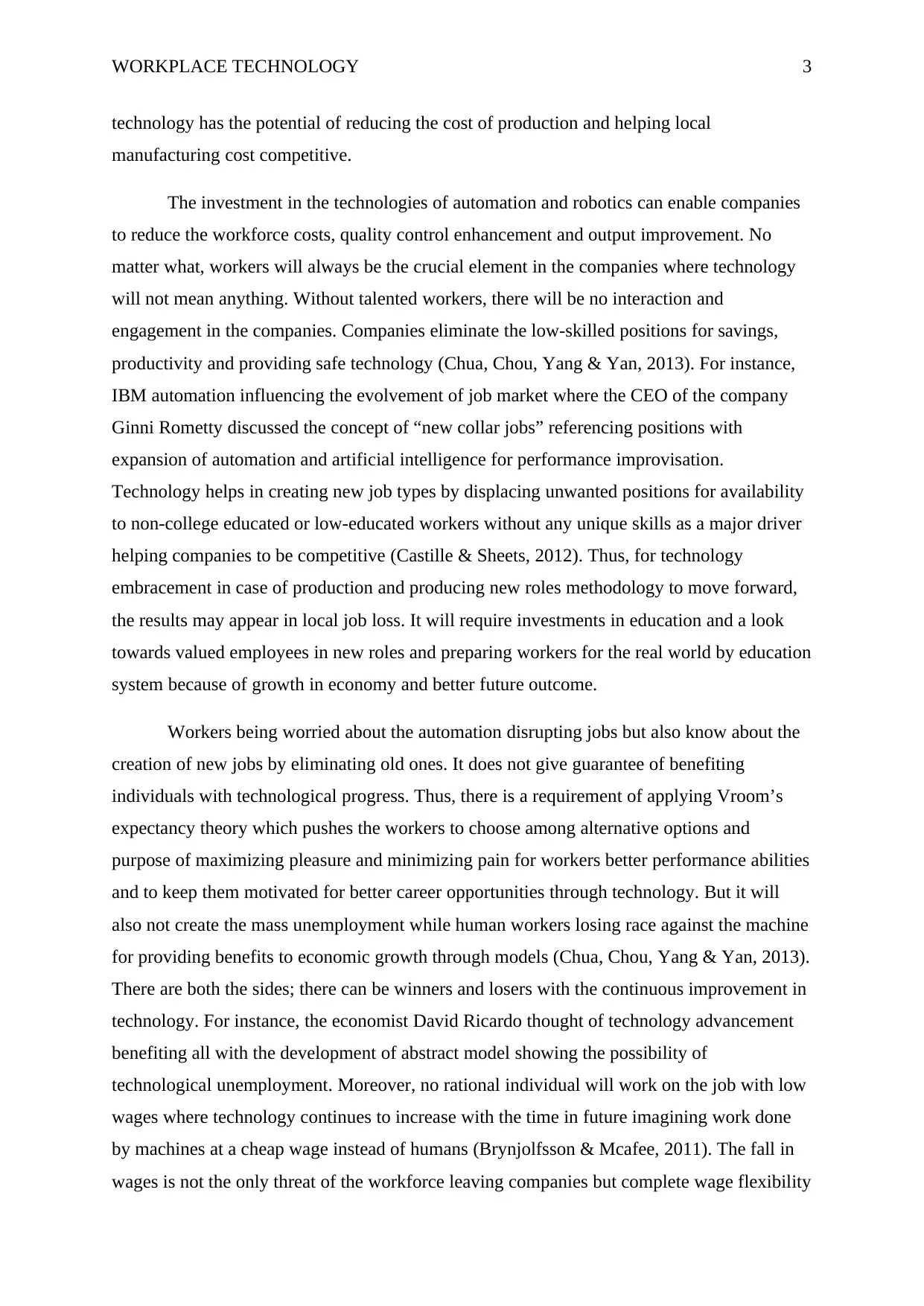
WORKPLACE TECHNOLOGY 3
technology has the potential of reducing the cost of production and helping local
manufacturing cost competitive.
The investment in the technologies of automation and robotics can enable companies
to reduce the workforce costs, quality control enhancement and output improvement. No
matter what, workers will always be the crucial element in the companies where technology
will not mean anything. Without talented workers, there will be no interaction and
engagement in the companies. Companies eliminate the low-skilled positions for savings,
productivity and providing safe technology (Chua, Chou, Yang & Yan, 2013). For instance,
IBM automation influencing the evolvement of job market where the CEO of the company
Ginni Rometty discussed the concept of “new collar jobs” referencing positions with
expansion of automation and artificial intelligence for performance improvisation.
Technology helps in creating new job types by displacing unwanted positions for availability
to non-college educated or low-educated workers without any unique skills as a major driver
helping companies to be competitive (Castille & Sheets, 2012). Thus, for technology
embracement in case of production and producing new roles methodology to move forward,
the results may appear in local job loss. It will require investments in education and a look
towards valued employees in new roles and preparing workers for the real world by education
system because of growth in economy and better future outcome.
Workers being worried about the automation disrupting jobs but also know about the
creation of new jobs by eliminating old ones. It does not give guarantee of benefiting
individuals with technological progress. Thus, there is a requirement of applying Vroom’s
expectancy theory which pushes the workers to choose among alternative options and
purpose of maximizing pleasure and minimizing pain for workers better performance abilities
and to keep them motivated for better career opportunities through technology. But it will
also not create the mass unemployment while human workers losing race against the machine
for providing benefits to economic growth through models (Chua, Chou, Yang & Yan, 2013).
There are both the sides; there can be winners and losers with the continuous improvement in
technology. For instance, the economist David Ricardo thought of technology advancement
benefiting all with the development of abstract model showing the possibility of
technological unemployment. Moreover, no rational individual will work on the job with low
wages where technology continues to increase with the time in future imagining work done
by machines at a cheap wage instead of humans (Brynjolfsson & Mcafee, 2011). The fall in
wages is not the only threat of the workforce leaving companies but complete wage flexibility
technology has the potential of reducing the cost of production and helping local
manufacturing cost competitive.
The investment in the technologies of automation and robotics can enable companies
to reduce the workforce costs, quality control enhancement and output improvement. No
matter what, workers will always be the crucial element in the companies where technology
will not mean anything. Without talented workers, there will be no interaction and
engagement in the companies. Companies eliminate the low-skilled positions for savings,
productivity and providing safe technology (Chua, Chou, Yang & Yan, 2013). For instance,
IBM automation influencing the evolvement of job market where the CEO of the company
Ginni Rometty discussed the concept of “new collar jobs” referencing positions with
expansion of automation and artificial intelligence for performance improvisation.
Technology helps in creating new job types by displacing unwanted positions for availability
to non-college educated or low-educated workers without any unique skills as a major driver
helping companies to be competitive (Castille & Sheets, 2012). Thus, for technology
embracement in case of production and producing new roles methodology to move forward,
the results may appear in local job loss. It will require investments in education and a look
towards valued employees in new roles and preparing workers for the real world by education
system because of growth in economy and better future outcome.
Workers being worried about the automation disrupting jobs but also know about the
creation of new jobs by eliminating old ones. It does not give guarantee of benefiting
individuals with technological progress. Thus, there is a requirement of applying Vroom’s
expectancy theory which pushes the workers to choose among alternative options and
purpose of maximizing pleasure and minimizing pain for workers better performance abilities
and to keep them motivated for better career opportunities through technology. But it will
also not create the mass unemployment while human workers losing race against the machine
for providing benefits to economic growth through models (Chua, Chou, Yang & Yan, 2013).
There are both the sides; there can be winners and losers with the continuous improvement in
technology. For instance, the economist David Ricardo thought of technology advancement
benefiting all with the development of abstract model showing the possibility of
technological unemployment. Moreover, no rational individual will work on the job with low
wages where technology continues to increase with the time in future imagining work done
by machines at a cheap wage instead of humans (Brynjolfsson & Mcafee, 2011). The fall in
wages is not the only threat of the workforce leaving companies but complete wage flexibility
Paraphrase This Document
Need a fresh take? Get an instant paraphrase of this document with our AI Paraphraser
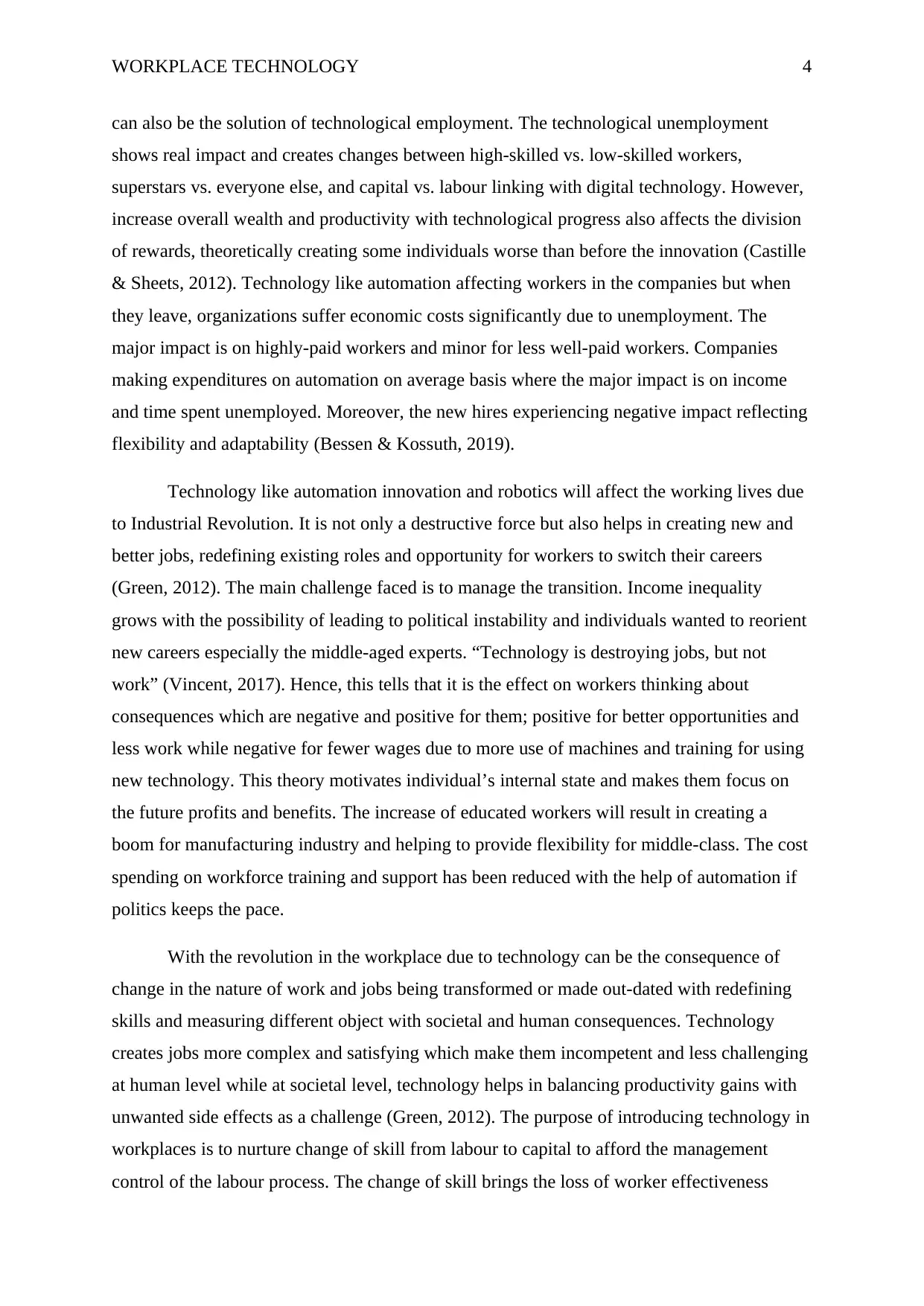
WORKPLACE TECHNOLOGY 4
can also be the solution of technological employment. The technological unemployment
shows real impact and creates changes between high-skilled vs. low-skilled workers,
superstars vs. everyone else, and capital vs. labour linking with digital technology. However,
increase overall wealth and productivity with technological progress also affects the division
of rewards, theoretically creating some individuals worse than before the innovation (Castille
& Sheets, 2012). Technology like automation affecting workers in the companies but when
they leave, organizations suffer economic costs significantly due to unemployment. The
major impact is on highly-paid workers and minor for less well-paid workers. Companies
making expenditures on automation on average basis where the major impact is on income
and time spent unemployed. Moreover, the new hires experiencing negative impact reflecting
flexibility and adaptability (Bessen & Kossuth, 2019).
Technology like automation innovation and robotics will affect the working lives due
to Industrial Revolution. It is not only a destructive force but also helps in creating new and
better jobs, redefining existing roles and opportunity for workers to switch their careers
(Green, 2012). The main challenge faced is to manage the transition. Income inequality
grows with the possibility of leading to political instability and individuals wanted to reorient
new careers especially the middle-aged experts. “Technology is destroying jobs, but not
work” (Vincent, 2017). Hence, this tells that it is the effect on workers thinking about
consequences which are negative and positive for them; positive for better opportunities and
less work while negative for fewer wages due to more use of machines and training for using
new technology. This theory motivates individual’s internal state and makes them focus on
the future profits and benefits. The increase of educated workers will result in creating a
boom for manufacturing industry and helping to provide flexibility for middle-class. The cost
spending on workforce training and support has been reduced with the help of automation if
politics keeps the pace.
With the revolution in the workplace due to technology can be the consequence of
change in the nature of work and jobs being transformed or made out-dated with redefining
skills and measuring different object with societal and human consequences. Technology
creates jobs more complex and satisfying which make them incompetent and less challenging
at human level while at societal level, technology helps in balancing productivity gains with
unwanted side effects as a challenge (Green, 2012). The purpose of introducing technology in
workplaces is to nurture change of skill from labour to capital to afford the management
control of the labour process. The change of skill brings the loss of worker effectiveness
can also be the solution of technological employment. The technological unemployment
shows real impact and creates changes between high-skilled vs. low-skilled workers,
superstars vs. everyone else, and capital vs. labour linking with digital technology. However,
increase overall wealth and productivity with technological progress also affects the division
of rewards, theoretically creating some individuals worse than before the innovation (Castille
& Sheets, 2012). Technology like automation affecting workers in the companies but when
they leave, organizations suffer economic costs significantly due to unemployment. The
major impact is on highly-paid workers and minor for less well-paid workers. Companies
making expenditures on automation on average basis where the major impact is on income
and time spent unemployed. Moreover, the new hires experiencing negative impact reflecting
flexibility and adaptability (Bessen & Kossuth, 2019).
Technology like automation innovation and robotics will affect the working lives due
to Industrial Revolution. It is not only a destructive force but also helps in creating new and
better jobs, redefining existing roles and opportunity for workers to switch their careers
(Green, 2012). The main challenge faced is to manage the transition. Income inequality
grows with the possibility of leading to political instability and individuals wanted to reorient
new careers especially the middle-aged experts. “Technology is destroying jobs, but not
work” (Vincent, 2017). Hence, this tells that it is the effect on workers thinking about
consequences which are negative and positive for them; positive for better opportunities and
less work while negative for fewer wages due to more use of machines and training for using
new technology. This theory motivates individual’s internal state and makes them focus on
the future profits and benefits. The increase of educated workers will result in creating a
boom for manufacturing industry and helping to provide flexibility for middle-class. The cost
spending on workforce training and support has been reduced with the help of automation if
politics keeps the pace.
With the revolution in the workplace due to technology can be the consequence of
change in the nature of work and jobs being transformed or made out-dated with redefining
skills and measuring different object with societal and human consequences. Technology
creates jobs more complex and satisfying which make them incompetent and less challenging
at human level while at societal level, technology helps in balancing productivity gains with
unwanted side effects as a challenge (Green, 2012). The purpose of introducing technology in
workplaces is to nurture change of skill from labour to capital to afford the management
control of the labour process. The change of skill brings the loss of worker effectiveness
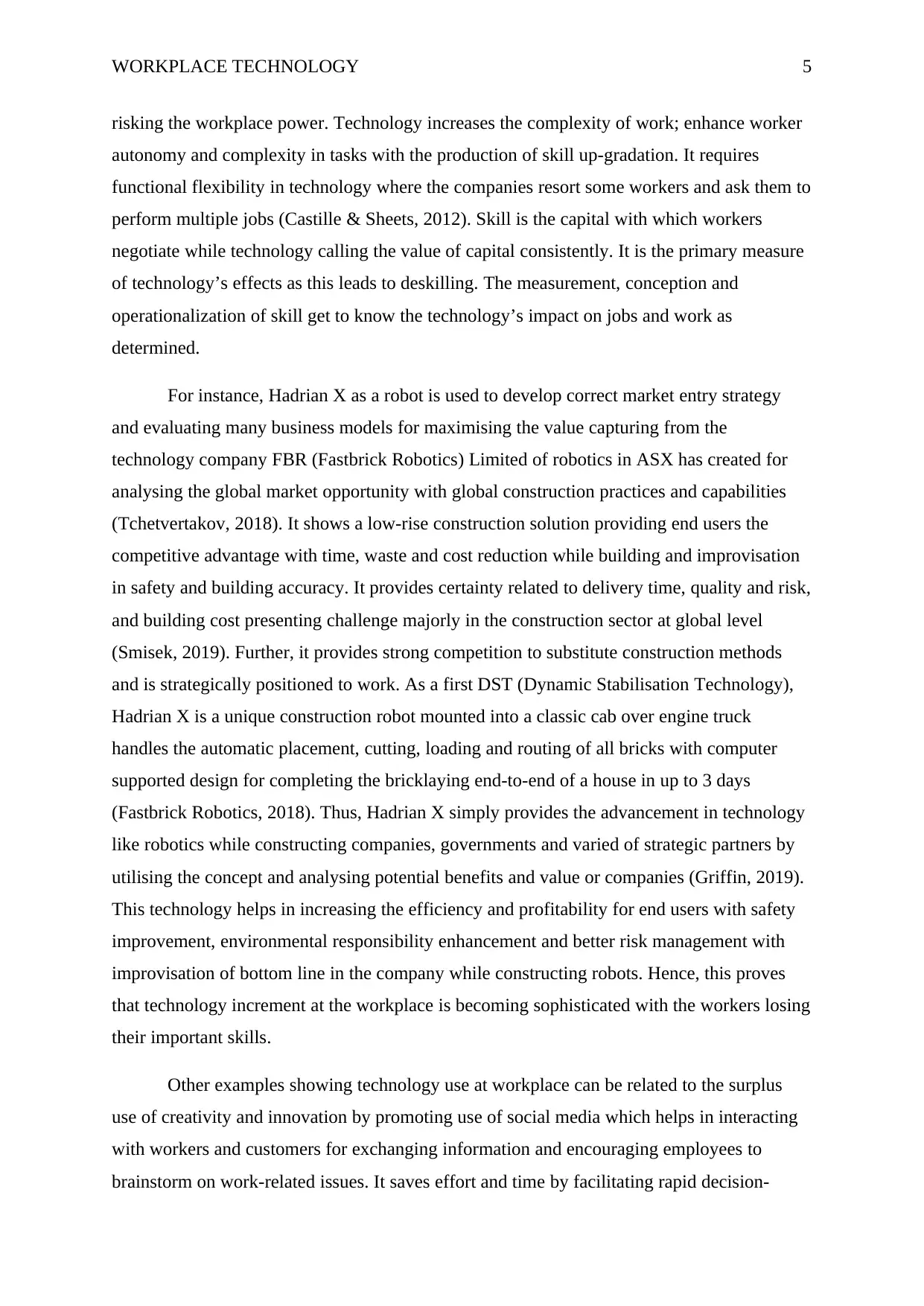
WORKPLACE TECHNOLOGY 5
risking the workplace power. Technology increases the complexity of work; enhance worker
autonomy and complexity in tasks with the production of skill up-gradation. It requires
functional flexibility in technology where the companies resort some workers and ask them to
perform multiple jobs (Castille & Sheets, 2012). Skill is the capital with which workers
negotiate while technology calling the value of capital consistently. It is the primary measure
of technology’s effects as this leads to deskilling. The measurement, conception and
operationalization of skill get to know the technology’s impact on jobs and work as
determined.
For instance, Hadrian X as a robot is used to develop correct market entry strategy
and evaluating many business models for maximising the value capturing from the
technology company FBR (Fastbrick Robotics) Limited of robotics in ASX has created for
analysing the global market opportunity with global construction practices and capabilities
(Tchetvertakov, 2018). It shows a low-rise construction solution providing end users the
competitive advantage with time, waste and cost reduction while building and improvisation
in safety and building accuracy. It provides certainty related to delivery time, quality and risk,
and building cost presenting challenge majorly in the construction sector at global level
(Smisek, 2019). Further, it provides strong competition to substitute construction methods
and is strategically positioned to work. As a first DST (Dynamic Stabilisation Technology),
Hadrian X is a unique construction robot mounted into a classic cab over engine truck
handles the automatic placement, cutting, loading and routing of all bricks with computer
supported design for completing the bricklaying end-to-end of a house in up to 3 days
(Fastbrick Robotics, 2018). Thus, Hadrian X simply provides the advancement in technology
like robotics while constructing companies, governments and varied of strategic partners by
utilising the concept and analysing potential benefits and value or companies (Griffin, 2019).
This technology helps in increasing the efficiency and profitability for end users with safety
improvement, environmental responsibility enhancement and better risk management with
improvisation of bottom line in the company while constructing robots. Hence, this proves
that technology increment at the workplace is becoming sophisticated with the workers losing
their important skills.
Other examples showing technology use at workplace can be related to the surplus
use of creativity and innovation by promoting use of social media which helps in interacting
with workers and customers for exchanging information and encouraging employees to
brainstorm on work-related issues. It saves effort and time by facilitating rapid decision-
risking the workplace power. Technology increases the complexity of work; enhance worker
autonomy and complexity in tasks with the production of skill up-gradation. It requires
functional flexibility in technology where the companies resort some workers and ask them to
perform multiple jobs (Castille & Sheets, 2012). Skill is the capital with which workers
negotiate while technology calling the value of capital consistently. It is the primary measure
of technology’s effects as this leads to deskilling. The measurement, conception and
operationalization of skill get to know the technology’s impact on jobs and work as
determined.
For instance, Hadrian X as a robot is used to develop correct market entry strategy
and evaluating many business models for maximising the value capturing from the
technology company FBR (Fastbrick Robotics) Limited of robotics in ASX has created for
analysing the global market opportunity with global construction practices and capabilities
(Tchetvertakov, 2018). It shows a low-rise construction solution providing end users the
competitive advantage with time, waste and cost reduction while building and improvisation
in safety and building accuracy. It provides certainty related to delivery time, quality and risk,
and building cost presenting challenge majorly in the construction sector at global level
(Smisek, 2019). Further, it provides strong competition to substitute construction methods
and is strategically positioned to work. As a first DST (Dynamic Stabilisation Technology),
Hadrian X is a unique construction robot mounted into a classic cab over engine truck
handles the automatic placement, cutting, loading and routing of all bricks with computer
supported design for completing the bricklaying end-to-end of a house in up to 3 days
(Fastbrick Robotics, 2018). Thus, Hadrian X simply provides the advancement in technology
like robotics while constructing companies, governments and varied of strategic partners by
utilising the concept and analysing potential benefits and value or companies (Griffin, 2019).
This technology helps in increasing the efficiency and profitability for end users with safety
improvement, environmental responsibility enhancement and better risk management with
improvisation of bottom line in the company while constructing robots. Hence, this proves
that technology increment at the workplace is becoming sophisticated with the workers losing
their important skills.
Other examples showing technology use at workplace can be related to the surplus
use of creativity and innovation by promoting use of social media which helps in interacting
with workers and customers for exchanging information and encouraging employees to
brainstorm on work-related issues. It saves effort and time by facilitating rapid decision-
⊘ This is a preview!⊘
Do you want full access?
Subscribe today to unlock all pages.

Trusted by 1+ million students worldwide
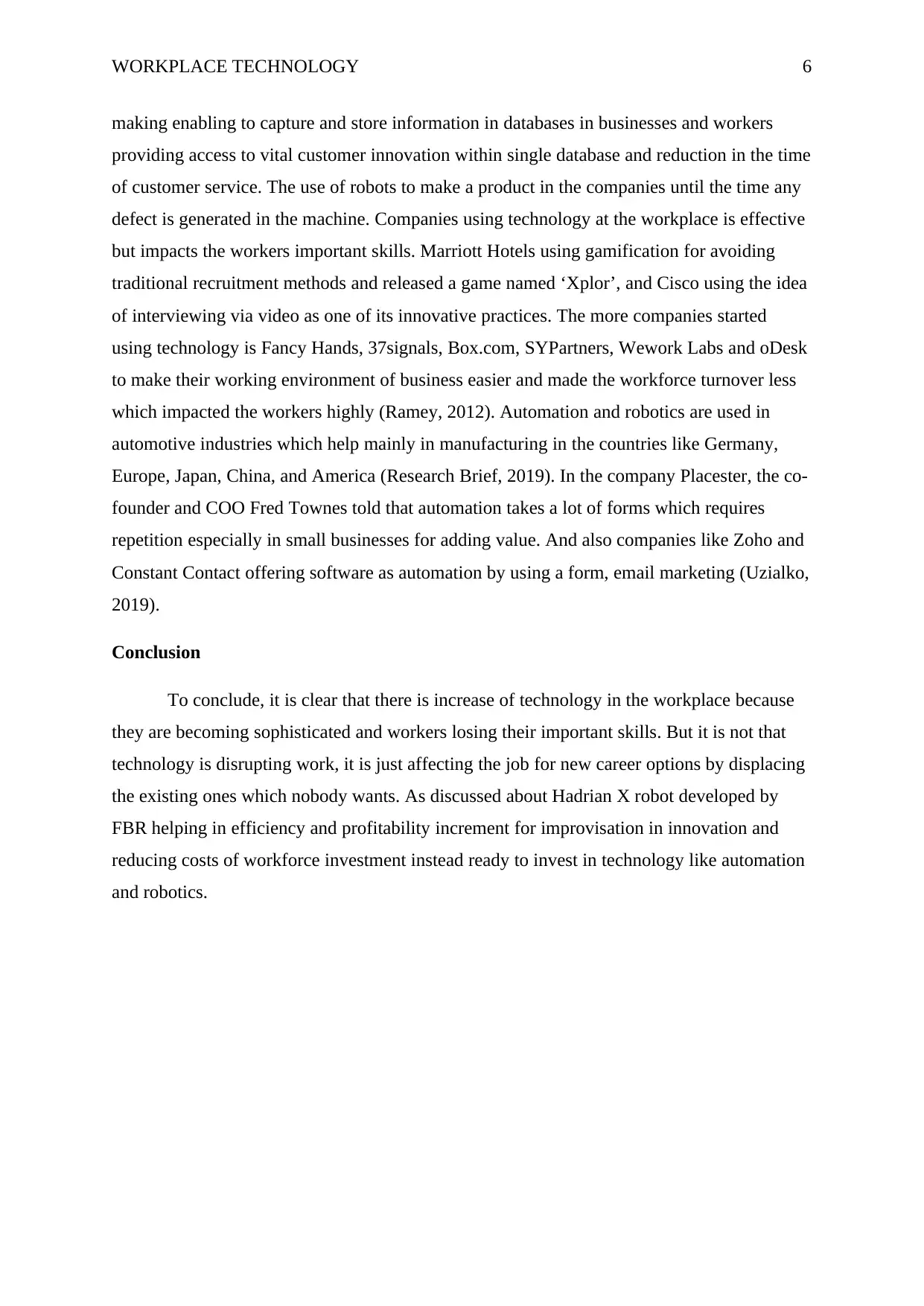
WORKPLACE TECHNOLOGY 6
making enabling to capture and store information in databases in businesses and workers
providing access to vital customer innovation within single database and reduction in the time
of customer service. The use of robots to make a product in the companies until the time any
defect is generated in the machine. Companies using technology at the workplace is effective
but impacts the workers important skills. Marriott Hotels using gamification for avoiding
traditional recruitment methods and released a game named ‘Xplor’, and Cisco using the idea
of interviewing via video as one of its innovative practices. The more companies started
using technology is Fancy Hands, 37signals, Box.com, SYPartners, Wework Labs and oDesk
to make their working environment of business easier and made the workforce turnover less
which impacted the workers highly (Ramey, 2012). Automation and robotics are used in
automotive industries which help mainly in manufacturing in the countries like Germany,
Europe, Japan, China, and America (Research Brief, 2019). In the company Placester, the co-
founder and COO Fred Townes told that automation takes a lot of forms which requires
repetition especially in small businesses for adding value. And also companies like Zoho and
Constant Contact offering software as automation by using a form, email marketing (Uzialko,
2019).
Conclusion
To conclude, it is clear that there is increase of technology in the workplace because
they are becoming sophisticated and workers losing their important skills. But it is not that
technology is disrupting work, it is just affecting the job for new career options by displacing
the existing ones which nobody wants. As discussed about Hadrian X robot developed by
FBR helping in efficiency and profitability increment for improvisation in innovation and
reducing costs of workforce investment instead ready to invest in technology like automation
and robotics.
making enabling to capture and store information in databases in businesses and workers
providing access to vital customer innovation within single database and reduction in the time
of customer service. The use of robots to make a product in the companies until the time any
defect is generated in the machine. Companies using technology at the workplace is effective
but impacts the workers important skills. Marriott Hotels using gamification for avoiding
traditional recruitment methods and released a game named ‘Xplor’, and Cisco using the idea
of interviewing via video as one of its innovative practices. The more companies started
using technology is Fancy Hands, 37signals, Box.com, SYPartners, Wework Labs and oDesk
to make their working environment of business easier and made the workforce turnover less
which impacted the workers highly (Ramey, 2012). Automation and robotics are used in
automotive industries which help mainly in manufacturing in the countries like Germany,
Europe, Japan, China, and America (Research Brief, 2019). In the company Placester, the co-
founder and COO Fred Townes told that automation takes a lot of forms which requires
repetition especially in small businesses for adding value. And also companies like Zoho and
Constant Contact offering software as automation by using a form, email marketing (Uzialko,
2019).
Conclusion
To conclude, it is clear that there is increase of technology in the workplace because
they are becoming sophisticated and workers losing their important skills. But it is not that
technology is disrupting work, it is just affecting the job for new career options by displacing
the existing ones which nobody wants. As discussed about Hadrian X robot developed by
FBR helping in efficiency and profitability increment for improvisation in innovation and
reducing costs of workforce investment instead ready to invest in technology like automation
and robotics.
Paraphrase This Document
Need a fresh take? Get an instant paraphrase of this document with our AI Paraphraser
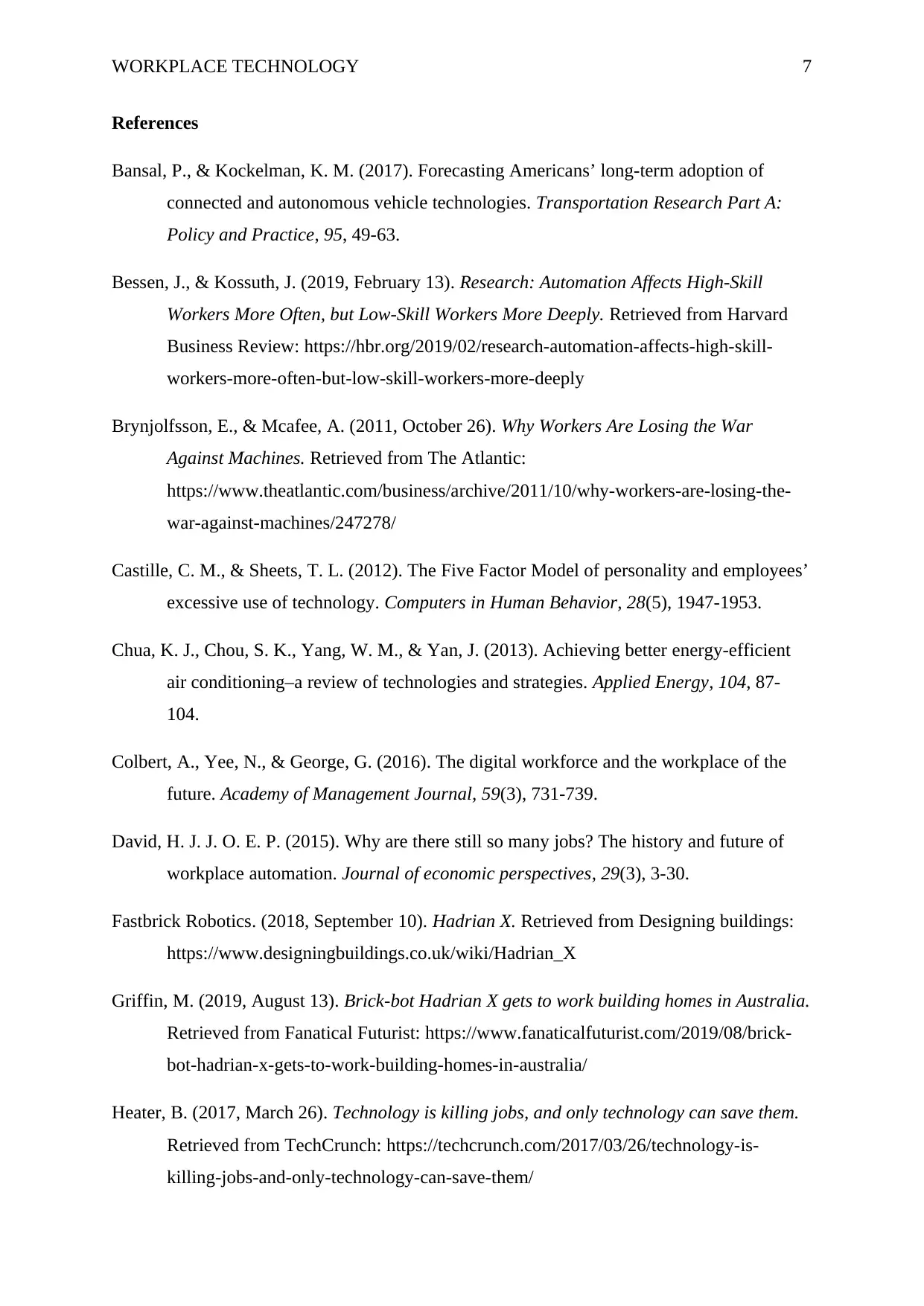
WORKPLACE TECHNOLOGY 7
References
Bansal, P., & Kockelman, K. M. (2017). Forecasting Americans’ long-term adoption of
connected and autonomous vehicle technologies. Transportation Research Part A:
Policy and Practice, 95, 49-63.
Bessen, J., & Kossuth, J. (2019, February 13). Research: Automation Affects High-Skill
Workers More Often, but Low-Skill Workers More Deeply. Retrieved from Harvard
Business Review: https://hbr.org/2019/02/research-automation-affects-high-skill-
workers-more-often-but-low-skill-workers-more-deeply
Brynjolfsson, E., & Mcafee, A. (2011, October 26). Why Workers Are Losing the War
Against Machines. Retrieved from The Atlantic:
https://www.theatlantic.com/business/archive/2011/10/why-workers-are-losing-the-
war-against-machines/247278/
Castille, C. M., & Sheets, T. L. (2012). The Five Factor Model of personality and employees’
excessive use of technology. Computers in Human Behavior, 28(5), 1947-1953.
Chua, K. J., Chou, S. K., Yang, W. M., & Yan, J. (2013). Achieving better energy-efficient
air conditioning–a review of technologies and strategies. Applied Energy, 104, 87-
104.
Colbert, A., Yee, N., & George, G. (2016). The digital workforce and the workplace of the
future. Academy of Management Journal, 59(3), 731-739.
David, H. J. J. O. E. P. (2015). Why are there still so many jobs? The history and future of
workplace automation. Journal of economic perspectives, 29(3), 3-30.
Fastbrick Robotics. (2018, September 10). Hadrian X. Retrieved from Designing buildings:
https://www.designingbuildings.co.uk/wiki/Hadrian_X
Griffin, M. (2019, August 13). Brick-bot Hadrian X gets to work building homes in Australia.
Retrieved from Fanatical Futurist: https://www.fanaticalfuturist.com/2019/08/brick-
bot-hadrian-x-gets-to-work-building-homes-in-australia/
Heater, B. (2017, March 26). Technology is killing jobs, and only technology can save them.
Retrieved from TechCrunch: https://techcrunch.com/2017/03/26/technology-is-
killing-jobs-and-only-technology-can-save-them/
References
Bansal, P., & Kockelman, K. M. (2017). Forecasting Americans’ long-term adoption of
connected and autonomous vehicle technologies. Transportation Research Part A:
Policy and Practice, 95, 49-63.
Bessen, J., & Kossuth, J. (2019, February 13). Research: Automation Affects High-Skill
Workers More Often, but Low-Skill Workers More Deeply. Retrieved from Harvard
Business Review: https://hbr.org/2019/02/research-automation-affects-high-skill-
workers-more-often-but-low-skill-workers-more-deeply
Brynjolfsson, E., & Mcafee, A. (2011, October 26). Why Workers Are Losing the War
Against Machines. Retrieved from The Atlantic:
https://www.theatlantic.com/business/archive/2011/10/why-workers-are-losing-the-
war-against-machines/247278/
Castille, C. M., & Sheets, T. L. (2012). The Five Factor Model of personality and employees’
excessive use of technology. Computers in Human Behavior, 28(5), 1947-1953.
Chua, K. J., Chou, S. K., Yang, W. M., & Yan, J. (2013). Achieving better energy-efficient
air conditioning–a review of technologies and strategies. Applied Energy, 104, 87-
104.
Colbert, A., Yee, N., & George, G. (2016). The digital workforce and the workplace of the
future. Academy of Management Journal, 59(3), 731-739.
David, H. J. J. O. E. P. (2015). Why are there still so many jobs? The history and future of
workplace automation. Journal of economic perspectives, 29(3), 3-30.
Fastbrick Robotics. (2018, September 10). Hadrian X. Retrieved from Designing buildings:
https://www.designingbuildings.co.uk/wiki/Hadrian_X
Griffin, M. (2019, August 13). Brick-bot Hadrian X gets to work building homes in Australia.
Retrieved from Fanatical Futurist: https://www.fanaticalfuturist.com/2019/08/brick-
bot-hadrian-x-gets-to-work-building-homes-in-australia/
Heater, B. (2017, March 26). Technology is killing jobs, and only technology can save them.
Retrieved from TechCrunch: https://techcrunch.com/2017/03/26/technology-is-
killing-jobs-and-only-technology-can-save-them/
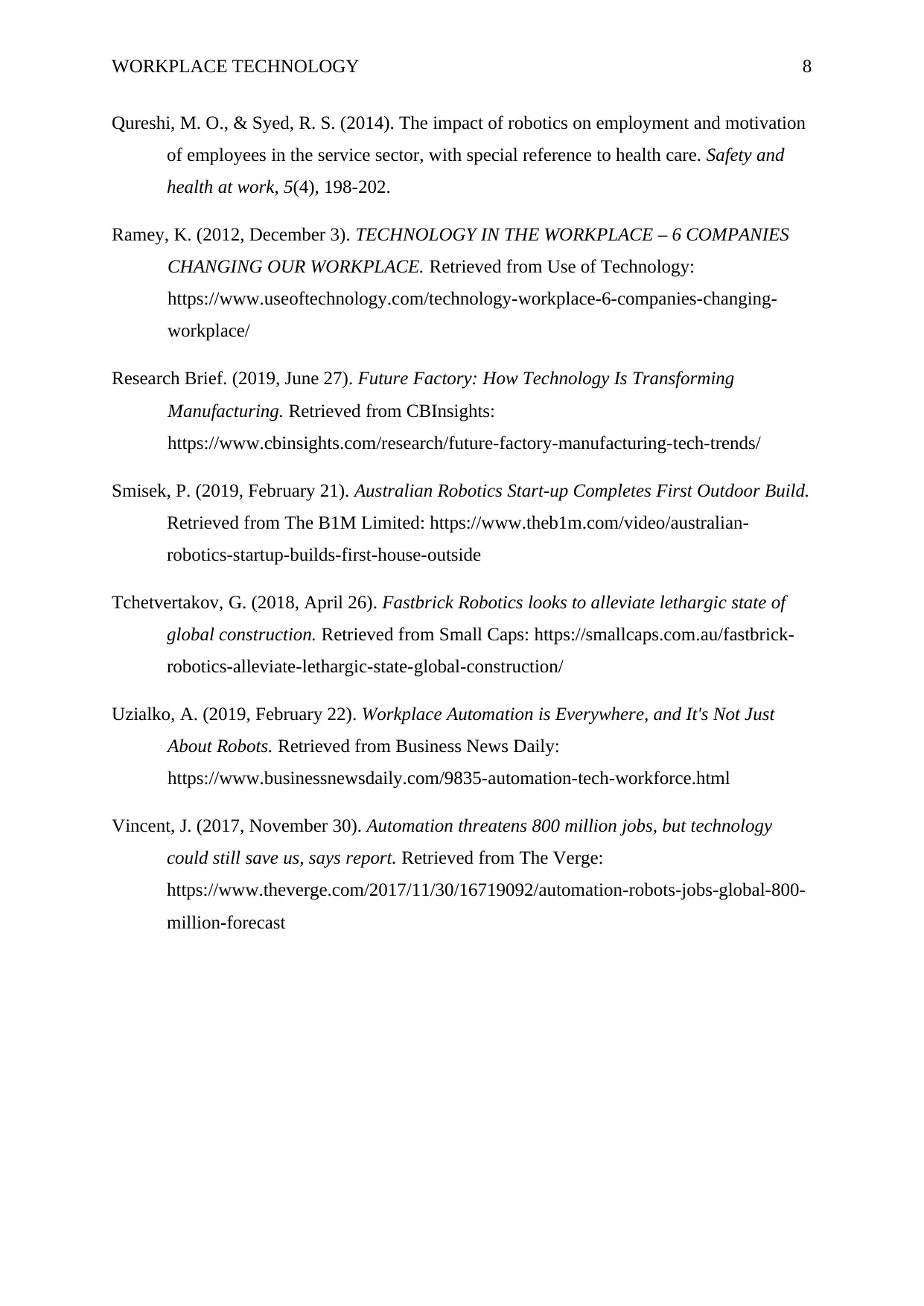
WORKPLACE TECHNOLOGY 8
Qureshi, M. O., & Syed, R. S. (2014). The impact of robotics on employment and motivation
of employees in the service sector, with special reference to health care. Safety and
health at work, 5(4), 198-202.
Ramey, K. (2012, December 3). TECHNOLOGY IN THE WORKPLACE – 6 COMPANIES
CHANGING OUR WORKPLACE. Retrieved from Use of Technology:
https://www.useoftechnology.com/technology-workplace-6-companies-changing-
workplace/
Research Brief. (2019, June 27). Future Factory: How Technology Is Transforming
Manufacturing. Retrieved from CBInsights:
https://www.cbinsights.com/research/future-factory-manufacturing-tech-trends/
Smisek, P. (2019, February 21). Australian Robotics Start-up Completes First Outdoor Build.
Retrieved from The B1M Limited: https://www.theb1m.com/video/australian-
robotics-startup-builds-first-house-outside
Tchetvertakov, G. (2018, April 26). Fastbrick Robotics looks to alleviate lethargic state of
global construction. Retrieved from Small Caps: https://smallcaps.com.au/fastbrick-
robotics-alleviate-lethargic-state-global-construction/
Uzialko, A. (2019, February 22). Workplace Automation is Everywhere, and It's Not Just
About Robots. Retrieved from Business News Daily:
https://www.businessnewsdaily.com/9835-automation-tech-workforce.html
Vincent, J. (2017, November 30). Automation threatens 800 million jobs, but technology
could still save us, says report. Retrieved from The Verge:
https://www.theverge.com/2017/11/30/16719092/automation-robots-jobs-global-800-
million-forecast
Qureshi, M. O., & Syed, R. S. (2014). The impact of robotics on employment and motivation
of employees in the service sector, with special reference to health care. Safety and
health at work, 5(4), 198-202.
Ramey, K. (2012, December 3). TECHNOLOGY IN THE WORKPLACE – 6 COMPANIES
CHANGING OUR WORKPLACE. Retrieved from Use of Technology:
https://www.useoftechnology.com/technology-workplace-6-companies-changing-
workplace/
Research Brief. (2019, June 27). Future Factory: How Technology Is Transforming
Manufacturing. Retrieved from CBInsights:
https://www.cbinsights.com/research/future-factory-manufacturing-tech-trends/
Smisek, P. (2019, February 21). Australian Robotics Start-up Completes First Outdoor Build.
Retrieved from The B1M Limited: https://www.theb1m.com/video/australian-
robotics-startup-builds-first-house-outside
Tchetvertakov, G. (2018, April 26). Fastbrick Robotics looks to alleviate lethargic state of
global construction. Retrieved from Small Caps: https://smallcaps.com.au/fastbrick-
robotics-alleviate-lethargic-state-global-construction/
Uzialko, A. (2019, February 22). Workplace Automation is Everywhere, and It's Not Just
About Robots. Retrieved from Business News Daily:
https://www.businessnewsdaily.com/9835-automation-tech-workforce.html
Vincent, J. (2017, November 30). Automation threatens 800 million jobs, but technology
could still save us, says report. Retrieved from The Verge:
https://www.theverge.com/2017/11/30/16719092/automation-robots-jobs-global-800-
million-forecast
⊘ This is a preview!⊘
Do you want full access?
Subscribe today to unlock all pages.

Trusted by 1+ million students worldwide
1 out of 9
Related Documents
Your All-in-One AI-Powered Toolkit for Academic Success.
+13062052269
info@desklib.com
Available 24*7 on WhatsApp / Email
![[object Object]](/_next/static/media/star-bottom.7253800d.svg)
Unlock your academic potential
Copyright © 2020–2025 A2Z Services. All Rights Reserved. Developed and managed by ZUCOL.





